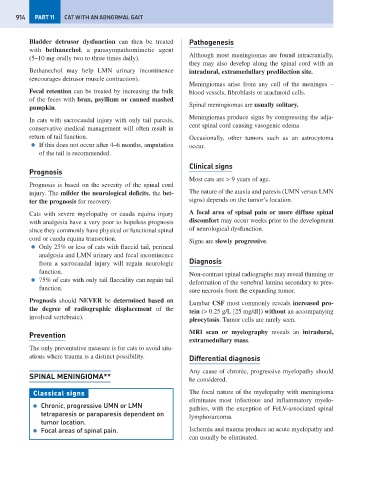Page 922 - Problem-Based Feline Medicine
P. 922
914 PART 11 CAT WITH AN ABNORMAL GAIT
Bladder detrusor dysfunction can then be treated Pathogenesis
with bethanechol, a parasympathomimetic agent
Although most meningiomas are found intracranially,
(5–10 mg orally two to three times daily).
they may also develop along the spinal cord with an
Bethanechol may help LMN urinary incontinence intradural, extramedullary predilection site.
(encourages detrusor muscle contraction).
Meningiomas arise from any cell of the meninges –
Fecal retention can be treated by increasing the bulk blood vessels, fibroblasts or arachnoid cells.
of the feces with bran, psyllium or canned mashed
Spinal meningiomas are usually solitary.
pumpkin.
Meningiomas produce signs by compressing the adja-
In cats with sacrocaudal injury with only tail paresis,
cent spinal cord causing vasogenic edema
conservative medical management will often result in
return of tail function. Occasionally, other tumors such as an astrocytoma
● If this does not occur after 4–6 months, amputation occur.
of the tail is recommended.
Clinical signs
Prognosis
Most cats are > 9 years of age.
Prognosis is based on the severity of the spinal cord
injury. The milder the neurological deficits, the bet- The nature of the ataxia and paresis (UMN versus LMN
ter the prognosis for recovery. signs) depends on the tumor’s location.
Cats with severe myelopathy or cauda equina injury A focal area of spinal pain or more diffuse spinal
with analgesia have a very poor to hopeless prognosis discomfort may occur weeks prior to the development
since they commonly have physical or functional spinal of neurological dysfunction.
cord or cauda equina transection.
Signs are slowly progressive.
● Only 25% or less of cats with flaccid tail, perineal
analgesia and LMN urinary and fecal incontinence
from a sacrocaudal injury will regain neurologic Diagnosis
function.
Non-contrast spinal radiographs may reveal thinning or
● 75% of cats with only tail flaccidity can regain tail
deformation of the vertebral lamina secondary to pres-
function.
sure necrosis from the expanding tumor.
Prognosis should NEVER be determined based on
Lumbar CSF most commonly reveals increased pro-
the degree of radiographic displacement of the
tein (> 0.25 g/L [25 mg/dl]) without an accompanying
involved vertebra(e).
pleocytosis. Tumor cells are rarely seen.
MRI scan or myelography reveals an intradural,
Prevention
extramedullary mass.
The only preventative measure is for cats to avoid situ-
ations where trauma is a distinct possibility. Differential diagnosis
Any cause of chronic, progressive myelopathy should
SPINAL MENINGIOMA**
be considered.
Classical signs The focal nature of the myelopathy with meningioma
eliminates most infectious and inflammatory myelo-
● Chronic, progressive UMN or LMN
pathies, with the exception of FeLV-associated spinal
tetraparesis or paraparesis dependent on
lymphosarcoma.
tumor location.
● Focal areas of spinal pain. Ischemia and trauma produce an acute myelopathy and
can usually be eliminated.

